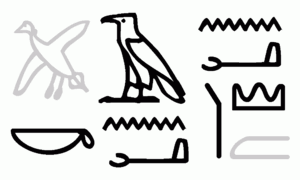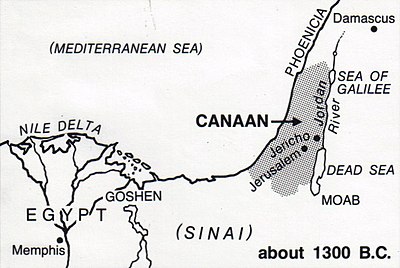Canaan
Canaan ( northwest Semitic kn'n, Alalach ki-in-a-nim KI , Akkadian LU ki-na-aḫ-num MEŠ , Assyrian KUR ki-na-aḫ-ḫi and KUR ki-na-ḫi, Babylonian KUR ki-na -ḫa-aau, Hurrian KUR ki-na-a-aḫ-ḫi, Hittite KUR URU ki-na-aḫ-ḫa, Arabic کنعان(Kanʿān), Hebrew כְּנַעַן (Kena'an), Egyptian p 3 -k- 3 -n-ˁ-n-ˁ, Phoenician Kenaʻ, ancient Greek Χαναάν Chanaán ) was mainly used in antiquity to denote the southwestern Syrian region and from the end of the 2nd millennium BC Extended to the area of Palestine (Pleschet) .

The use of the name Canaan is documented under Seleucus I , who called himself "the L'dk 'in Canaan". The Roman occupation replaced "Canaan" with the name Syria , the borders of which neither coincided with the extent of the earlier Canaan nor with the borders of today's Syria .
etymology
The exact interpretation of the name of Canaan remains unclear. In Egyptian texts, the term Canaan is usually given negative titles: "Robbers and Canaanites, rebellious inhabitants in Canaan".
The derivation from the later Aramaic , Hebrew and Arabic languages using the root kn 'enables the following interpretations: "The writhing, the hunched, the bowed, the humiliated, the cast out, the subjugated" and "the withdrawn".
history
The urban development of the region followed that in Egypt and Mesopotamia. Exceptions were Jericho and En Esur . The first other cities in the southern Levant are believed to have been around 2100 BC. It was founded and abandoned again, but trade routes between the high cultures remained. Already at this point in time the Amurites are mentioned in Sumerian sources as residents of the Levant.
The oldest archaeological find that literally mentions Canaan is the statue of Idrimi , King of Alalach in what is now Hatay . This tells the life story of Idrimis, who moved to Canaan as a political refugee. “Ammija is in Canaan. In Ammija there were also people from “the homeland of Idrimi, who called him their leader and finally sailed to Alalach and conquered the city. The king and the inscription are generally dated around 1450 BC. Dated. The Apiru are mentioned as residents of Canaan .
An important source for the region are the Amarna letters , which date from around 1350 BC. BC under King ( Pharaoh ) Akhenaten (Amenophis IV.) By different governors. A letter from Labaju of Shechem , a vassal of the Pharaoh, has survived from the Canaan area . He writes: “The king has sent a message concerning (the extradition) of my son. I did not know that my son was moving around with the ḫapiru men. ”(Letter EA 254) The semi-nomads, referred to as“ outlaws ”in the letters, were a powerful force at this point in time who threatened the vassal city states of the Pharaoh. The letter also shows that the vassals cooperated with the Apiru when it seemed convenient.
In letter EA 8 Burna-buriaš II of Babylonia demands compensation from King Akhenaten for an attack on a trade embassy that was attacked in Canaan because it "belongs to Egypt".
Text documents about Canaan are also known from Ugarit , Aššur and Ḫattuša , which make it clear that the local rulers were vassals of the Egyptian pharaohs.
The most important Canaanite cities are likely to have been Hazor , Megiddo and Lachish . Hazor could have been inhabited by the Amurites. To the north of the Canaanite city-states was the loosely controlled Amurru . The Canaanite languages formed a dialect continuum of the Northwest Semitic languages .
In the 2nd millennium BC BC Canaan was largely under Egyptian rule until the Egyptians with the appearance of the " sea peoples " from the 12th century BC. Chr. Gradually lost control of the Levant. The new geographical allocation by Egypt at the time took into account the changed political conditions . While under Pharaoh Merenptah Canaan was still mentioned as an independent area, under Ramses III. the political assignment to the suzerainty of the Philistines : "Messenger to Canaan in the land of Palastu".
The Aramaeans advanced south from Syria a little later . At the same time, “new” groups appeared in the Egyptian sources in Canaan itself: the Israelites ( conquering the land ) in central Israel and other peoples on the periphery of the cultivated land such as the Moabites . In a time of decreasing external pressure, several native states were able to develop, which was subsequently associated with a pronounced ethnogenesis . The Phoenicians and Philistines did not oppose the Israelite state of the early kings with a comparable trend towards the "area state", where city-states continued to form the largest political units.
The land of Canaan in a biblical context
The personal name Canaan appears for the first time in Genesis 9:18 EU . There he is mentioned as the son of Ham , who in turn was one of the three sons of Noah . Canaan appears again expressly as the son of Ham in Genesis 10.6 EU . In Gen 10.15–19 EU , the Phoenician city Sidon , Heth and nine other peoples names are listed as his “descendants”, suggesting a connection between “Canaan” and Phenicia.
According to the account of the 1st book of Moses (chapter 12 ff.) In the Torah , the land is called Canaan (actually in Hebrew אֶרֶץ כְּנַעַן ärätz kena'an , German 'land of Canaan' ) the promised land to Abraham and his descendants ( promised land ). In addition to the summary designation Canaan for the non-Israelite pre-population of the country, these are also referred to as the children of the Heths or Hittites (e.g. Gen 27.46 EU ) or as Amorites (e.g. Gen 15.16 EU ). In still other places there are lists of folk names which, in recurring lists, combine these summary names with other historically less concrete names to form a list of peoples who have never lived next to each other in the country. In Deut 7.1 EU , seven names of peoples are apparently put together consciously, the Hittites, Girgaschites , Amorites, Canaanites (in the narrower sense), Perizzites , Hivites and Jebusites , cf. also already Gen 15: 19-20 EU .
According to the biblical report, the promise made to Abraham in Mesopotamia after the report of Genesis was followed by the peaceful immigration of the ancestors of the Israelites, who would have lived alongside the Canaanites in the country ( Gen 12.6 EU ). It was only after leaving Egypt , centuries later, that the people of Israel would finally have conquered the land and expelled the Canaanites , albeit not completely ( Judges 1,27–33 EU ). The biblical representation is exaggerated by legend and has no reference to historical events, as is particularly clear from the report of the collapsing walls of Jericho ( Jos 6 EU ) or that of the Battle of Gibeon , where the moon and sun are said to have stood still until the Israelites were victorious had ( Jos 10,12-14 EU ). The biblical narratives thus tell of military conquest as well as peaceful settlement. However, modern research doubts whether Israel immigrated to the country from outside at all, because there is no archaeological evidence for this. Today it is more and more assumed that Israel arose in the country itself (autochthonous) and that the religious contrast to Canaan was only retrospectively projected back into prehistoric times. In addition, the biblical report, which arose only centuries after the alleged events, contains a number of statements which, according to the current state of research, appear contradictory (see: → Landing of the Israelites ).
The warning against the fertility gods of Canaan, especially Ba'al (Bel) in all its variants, their rites and images, the cult heights, bull and calf idols ( golden calf ) mentioned in the Bible, pervades various books of the Tanach . The worship of the goddess of love ( Asherat ) is documented for the time of Solomon (see also Canaanite or Ugarite religion ).
In the Bible, in Exodus, Canaan is spoken of as the land where " milk and honey flow".
literature
- Wayne Horowitz, Takayoshi Oshima: Cuneiform in Canaan. Cuneiform Sources from the Land of Israel in Ancient Times. Israel Exploration Society, Jerusalem 2006, ISBN 965-221-062-5 .
- Benjamin Mazar : Canaan and the Canaanites. Bulletin of the American Schools of Oriental Research 102, 1946, pp. 7-12.
- JN Tubb: Peoples of the Land of Canaan (Peoples of Antiquity). Scientific Book Society , Darmstadt 2005.
Notes and individual references
- ↑ Rejecting this (“Etymology and word meaning of 'K.'… unclear”) M. Weippert: Kanaan, In: Dietz-Otto Edzard et al. (Ed.): Reallexikon der Assyriologie und Vorderasiatischen Aräologie , Vol. 5. De Gruyter, Berlin 1980, ISBN 3-11-007192-4 , p. 352.
- ^ Amélie Kuhrt: The Ancient Near East (Routledge History of the Ancient World) . 1st edition. Routledge, New York and London 1995, ISBN 0-415-01353-4 .
- ^ Anson F. Rainey: Letters from Palestine. In: TUAT NF 3 , p. 197.
- ↑ Nadav Na'aman: Canaan in the 2nd millennium BCE . Eisenbrauns, 2005, ISBN 978-1-57506-113-9 .
- ↑ See the Amurrian personal names in ancient Babylonian texts from Hazor, W. Horowitz, A. Shaffer: An Administrative Tablet from Hazor: A Preliminary Edition. In: Israel Exploration Journal. Vol. 42, 1992, pp. 21-33.
- ↑ Christian Frevel : Geschichte Israels , 2nd, expanded and revised edition, Stuttgart 2018, pp. 67–96.
